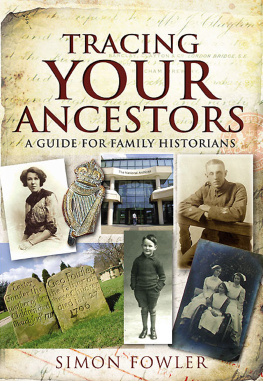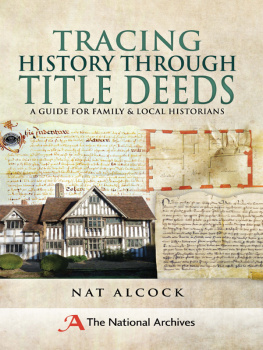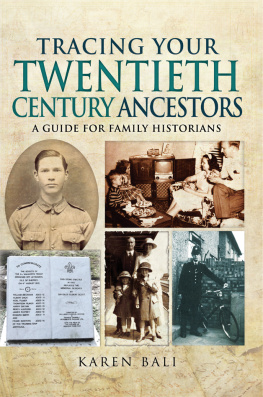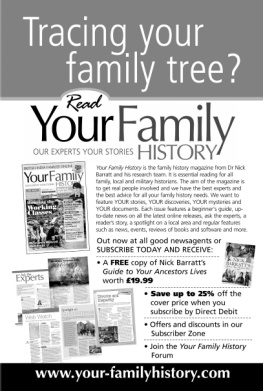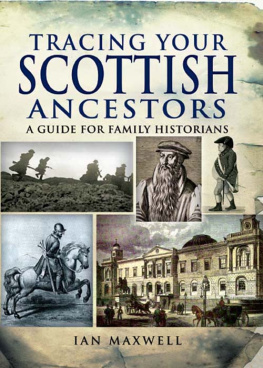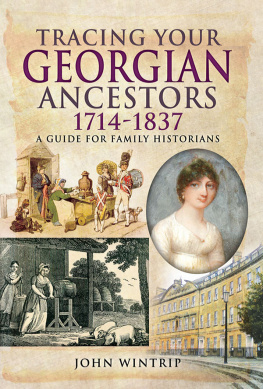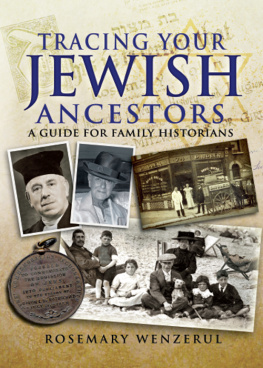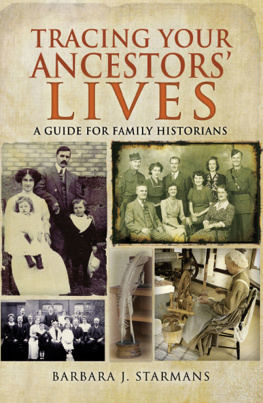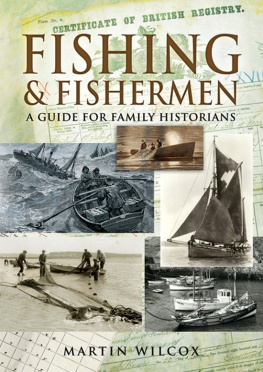FAMILY HISTORY FROM PEN & SWORD BOOKS
Tracing Your Yorkshire Ancestors
Rachel Bellerby
Tracing Your Royal Marine Ancestors
Richard Brooks and Matthew Little
Tracing Your Army Ancestors
Simon Fowler
A Guide to Military History on the Internet
Simon Fowler
Tracing Your Northern Ancestors
Keith Gregson
Your Irish Ancestors
Ian Maxwell
Tracing Your Air Force Ancestors
Phil Tomaselli
Tracing Your Jewish Ancestors
Rosemary Wenzerul

First published in Great Britain in 2010 by
PEN AND SWORD FAMILY HISTORY
an imprint of
Pen & Sword Books Ltd
47 Church Street
Barnsley
South Yorkshire
S70 2AS
Copyright Diane K. Drummond 2010
PRINT ISBN 978 1 84415 864 5
EPUB ISBN: 9781844686704
PRC ISBN: 9781844686711
The right of Diane K. Drummond to be identified as author of this
work has been asserted by her in accordance with the copyright,
Designs and Patents Act 1988.
A CIP catalogue record for this book is
available from the British Library
All rights reserved. No part of this book may be reproduced or
transmitted in any form or by any means, electronic or mechanical
including photocopying, recording or by any information storage and
retrieval system, without permission from the Publisher in writing.
Typeset in 10pt Palatino by Mac Style, Beverley, East Yorkshire
Printed and bound in the UK by CPI
Pen & Sword Books Ltd incorporates the Imprints of Pen & Sword
Aviation, Pen & Sword Maritime, Pen & Sword Military,
Wharncliffe Local History, Pen and Sword Select, Pen and Sword
Military Classics, Leo Cooper, Remember When, Seaforth Publishing
and Frontline Publishing.
For a complete list of Pen & Sword titles please contact
PEN & SWORD BOOKS LIMITED
47 Church Street, Barnsley, South Yorkshire, S70 2AS, England
E-mail:
Website: www.pen-and-sword.co.uk
DEDICATION
To my father, Peter Clark, and stepmother, Dorothy Clark (ne Billington)
ACKNOWLEDGEMENTS
A number of people should be thanked for their involvement in producing this book. First of all both Rupert Harding and Simon Fowler of Pen and Sword Books deserve mention for their advice and editorial support. My thanks also to Alison Miles for copy editing the text. My own interest in railway ancestors has been spurred on by those family historians who constantly work at uncovering their own genealogies. Of special mention is the North West Group of Family History Societies and the Family History Society of Cheshire, which so kindly invited me to talk about railway ancestors at the Working Lives conference in Northwich on 12 May 2007.
On a different note, the work of Audrey Giles and Dudley Clark in using family reconstitution methods in researching their doctoral theses on various aspects of railway work, religion and trade unionism have also been interesting and important. 1 might add that their endeavours far outweigh mine in this area!
Many thanks go to my stepmother, Dorothy Clark, for letting me use photographs of herself and other members of her railway family. Finally, I need to thank my husband, Ian Drummond, for making me go and get on with writing when I needed to, and our cats for dragging me away from it when 1 required a rest (or was it when they wanted some food?). As usual, any errors or omissions in this book are my responsibility.
Illustration credits
Most of the illustrations and photographs are either out of copyright, part of my own collection or both. The exceptions to this are: three photographs from Transport Treasury (on the jacket and pp. 59 and 133); one illustration from the Illustrated London News taken at the University of Leeds Special Collections (p. 32) and the photograph of Richard Mathews (p. 166), kindly given to me by my friend the late Howard Clayton of Stourport-on-Severn, Worcestershire. I have done my best to trace any other copyright holders and apologise if 1 have overlooked anyone. If this is the case, please contact me via the publishers and I will be happy to amend this in any future printings of this book.
Di Drummond
June 2009
INTRODUCTION: TRACING YOUR RAILWAY ANCESTORS
F inding a railway worker among your ancestors it is by no means unusual in Britain today The nations railways employed a massive workforce throughout much of their long history across the nineteenth and the twentieth centuries. By the 1870s a 1/4 million, some 3 per cent of those employed in Britain, worked on the railways. This number had risen to over 1/2 million by 1948 when the railways were nationalised at the end of the British Rail era. After the sweeping rationalisation of the nations railway network under Beeching and then under the Conservative governments of Margaret Thatcher and John Major, 125,000 were still employed on the system.

Your railway ancestors? A railwayman of the North Eastern Railway, his wife and daughter in the late nineteenth century. (Di Drummond Collection)

Dorothy Billington, the authors stepmother, at work in a railway office in Crewe during the 1960s. Dorothy was employed by British Railways/Rail all her working life, eventually becoming the manager of the typing pool at Rail House in Crewe. (Di Drummond Collection)
Finding a railway worker in the family is also often a source of great pride and interest for family historians. Railway workers were responsible not only for building, running and maintaining the railway system in Britain, but often went abroad to do similar service there. Take for instance my home town of Crewe and my stepmother Dorothy Clarks (ne Billington) family. Crewe has been described as the railway town par excellence, with over 69 per cent of the population in the town employed by the local railway company, the London and North Western, in 1881. For many generations the men of the Billington family were employed in Crewe railway workshops. As a member of a railway family, Dorothy herself joined Crewes London Midland and Scottish Railway, entering the companys General Offices as a typist in 1940. Dorothy represents one of the many generations of young women who found employment in various capacities on the railways. For the male members of the Billington family, and indeed many other railway workers and their families, their expertise in railway work and engineering took them all over the world. On completing their apprenticeships at Crewe Works, Billington men moved on to find employment in similar workshops across the world, settling in Canada, Australia and the USA. In going overseas the Billingtons were merely following a trend established in the 1850s and 1860s, where railway companies in various regions of the British Empire, such as India, insisted on employing British engineers, engineering workers, locomotive drivers and firemen. A great many civil engineers also went abroad to build railways, as did railway navvies recruited throughout the British Isles.
While it is not a central focus of this book, railway employment has also been responsible for other examples of international settlement and migration. Under the British Raj, for instance, while this policy of employing British people in key roles on the railway continued, lesser jobs on the line were given to Anglo-Indians (that is the descendants of mixed race relationships), and, later, to Indians themselves. Railway junctions and settlements in the Indian subcontinent were often distinctly Anglo-Indian in character, while the migration of Indian railway construction and service workers to Uganda was key to the establishment of the railway and the Indian community there during the early years of the twentieth century
Next page

